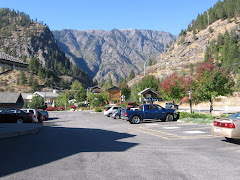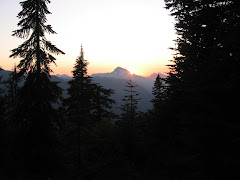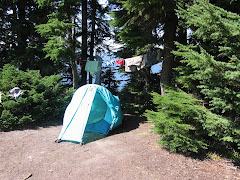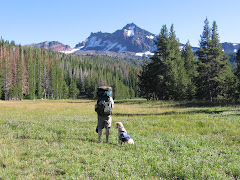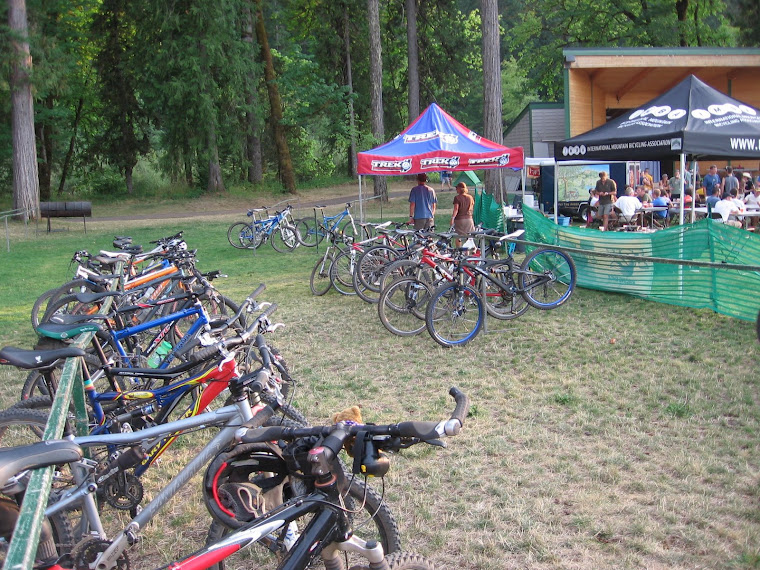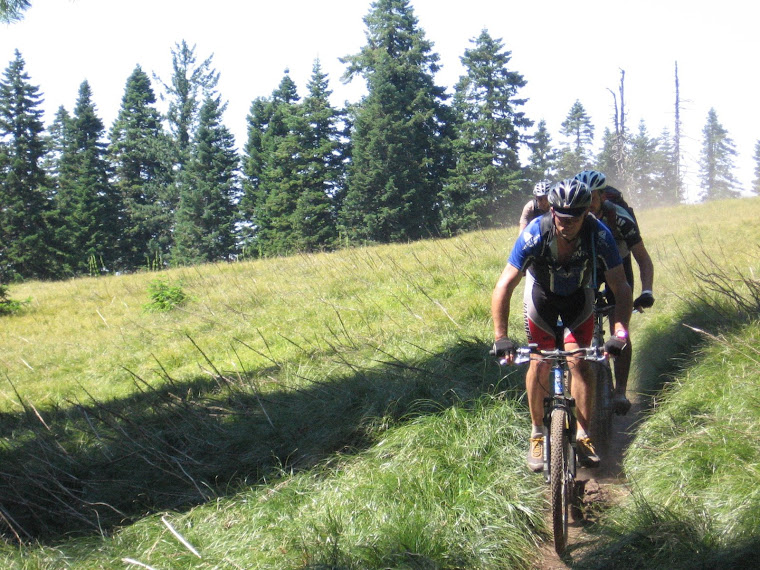 |
| The Mountain the afternoon before our summit. |
The Mountain resides in my back yard. On clear days you can see it, standing tall to the east. I see it almost daily when I'm flying--on takeoff from runway 10R at PDX, it looms large, as if standing guard; on approach from the east, we pass by around summit height; we overfly on north-south routes and get a bird's eye view. In the winter, The Mountain is cloaked in white. Sometimes she disappears for days under a thick blanket of cloud and emerges more brilliant than before. By summer's end, the receding glaciers are apparent and what little snow remains is brown with dirt. Some days, only the summit peak peeks above the clouds.
When I moved to Portland more than 10 years ago, my intent was to stay for two years--the time remaining in my boyfriend's law school career. Portland seemed exotic and perhaps out of my league, but I wanted to enjoy as many of its treasures as I could during my stay. At the time, I was heavy into rock climbing and moving to the Pacific Northwest seemed naturally to lead to mountaineering. At the very least, I should climb the closest peaks.
Somehow time went by. I did plenty of rock climbing in the early days. I hiked a lot. I mountain biked more and more and even started road biking. I learned to whitewater kayak and paddled weekly for years. But I never climbed The Mountain.
In May of 2002, the first spring I was in Portland, The Mountain suffered a climbing tragedy of Everest proportions. Nine climbers were swept into a crevasse just below the summit. Some died, others were injured. Then a helicopter crashed during a rescue attempt. Dozens of climbers set out for the summit nearly every day from May to mid July, but every year you only hear about the ones who don't return.
This year I established climbing The Mountain as one of my main goals for the summer. My friend Mark leads first-timers up every year, so I only had to ask and he put me on his training plan. We hiked steep trails in the Gorge, gradually adding weight to our packs. My work and play schedule restricted my participation in group training hikes, but I hiked on my own and did enough with Mark for him to have confidence in my fitness and ability.
Summit Day: Well, we actually rescheduled summit day due to iffy weather. New Summit Day: Mark picked me up at precisely midnight. I had carefully packed everything on the gear list Mark sent me via email earlier in the week (I struggled with the final item--"props for summit antic photos." I don't do cookie decorating parties, scrapbooking, theme parties, or costumes. I had no idea what to bring. In the end, I settled on my straw hat that I bought in the Badlands a few years back, a tie-dye scarf, and a hand-made sign that read "Summit Fever, Mt. Hood or Bust.") We drove to The Mountain and registered for our climb. Mark sifted through the other climber registrations to get an idea how many people were out that night, party sizes, route choices, etc. He picked a late start time to allow others to be ahead of us, blaze the trail, and provide summit beta on their way down. We set out at 2:15 a.m., 15 minutes ahead of target.
 |
| READY TO CLIMB |
Mark was yawning, but I felt wide awake. We stopped often to take in the constellations and the Milky Way clearly visible straight overhead streaking north to south. Before 4 a.m. a rosy glow was beginning to appear on the eastern horizon. By the time we stopped at the top of the Palmer Snowfield to don crampons, we no longer needed headlamps for hiking. Mark pointed out The Mountain's shadow to the west as the sun began to rise.
The climb steepened, but our crampons easily gripped what Mark called the "styrofoam snow." It was fairly fresh and perfectly firm but not icy. Soon we crested the lip of the crater--I never realized Mt. Hood had a crater, but being a volcano, of course it does. Pearly spires rim the north side and in the center lies the Devil's Kitchen, a smoldering fumarole who's sulfur smell reminded me of Yellowstone National Park. The sun was still below the mountain, leaving the crater in shadow. I was leading; we passed two young guys making their first climb with their father.
I hesitated at the crater to scout the route up to the Hogsback; a snow bridge to the left of Devil's Kitchen lay perilously close to a smaller fumarole that was melting the snow and leaving the bridge hollow underneath. Mark validated my concern; we stuck carefully to the center and thickest part of the bridge. Now we could see the two routes to the summit--the old Mazama chute to the left of the Hogsback, and the route through the Pearly Gates to the right. There were climbers ascending both routes, but the left side seemed more popular. Two (young, fit, male) climbers were descending as we traversed the slope below the Hogsback and Mark asked about the summit. They were the first up that morning, just at sunrise. They advised against the Pearly Gates route due to potential ice-fall from the cliffs above and noted that traction devices (ice axe and crampons) would be essential.
A short, steep pitch put us on the crest of the ridge that divided the two summit route choices. Above us, a crevasse was beginning to gape open; Mark said it's covered over in winter and opens wider as summer progresses. Our route would keep us well clear of it, but Mark emphasized the need to be aware of the fall line and of maintaining a position that would avoid it in the event of a fall. About that time, a rope team dropped a picket that tumbled several hundred feet down and into a hole below us, giving crystal clear meaning to the term "fall line."
We stashed our trekking poles and took our ice axes off our packs. I followed Mark on a short descent, then up and across a bare section of loose dirt and gravel, then onto a ridiculously steep snow face with not very good purchase. Mark was kicking steps into the snow and I was trying to improve them for the team behind me, but the texture didn't lend itself well to holding the shape. Ascending was easy enough, but it occurred to me that coming back down this would terrify me. I said as much to Mark and he looked at me with alarm. What I didn't know at the time was that these conditions were more challenging than usual for this time of year and not ideally suited to first time climbers, especially without ropes. The typical summit is on what Mark called a "stairway to heaven" that has been chiseled out by previous climbers. The previous week's fresh snow had obliterated the stairway, leaving us a hard surface that required diligent use of all available pointy tools. Adding to the challenge were several teams descending from the summit, kicking hard balls of snow down onto us.
At the head of this slope, the final climb to the summit was up a narrow chute occupied by rope teams descending. There was room to pass carefully and soon I was topping out on the summit ridge with the sun bright in my eyes! It was the Solstice and an exceptionally clear day. We could see all the way to Diamond Peak in southern Oregon, Saddle Mountain in the Coast Range (the mountain range blocked the view of the ocean itself), and Mt. Ranier to the north. The views were stunning, but the wind cold, so we minimized our time at the top, just taking a few minutes for photos.
The thing to remember about mountaineering is that the summit is only half way there and that most accidents occur while descending. This knowledge, coupled with my inherent dislike of going down steep things (my common phrase is "I would go up this thing three times if I only didn't have to go down it!") had my anxiety level high. Most sports I do have solid safety features built in and consequences are fairly benign. Here, the safety features were technical skill and trust in equipment. My skills were newly learned and I barely knew my equipment. A mis-step could easily lead to a fall; an experienced climber died here just last week. But there was no point in panicking or even allowing fear to settle in. I just had to stay calm and focus on the task at hand.
Mark started down the chute first and put a lot of effort into making foot holds for me to use. It was slow going, but easier for me (and the climbers who followed us) as a result. I quickly became an expert at front pointing (down climbing by facing the wall and digging the long front points of my crampons into the snow) and planting the ice axe--usually with the pick into the snow, but sometimes the shaft dug in in the self-belay position. Even when we reached the open slope where Mark was walking down the "steps" we tried to make on the way up, I felt more stable with the front pointing technique. My calves would later punish me for this.
After what seemed an eternity (especially since my bladder had been on the verge of exploding for most of the descent, due in part to nerves I think) we were back at the bare patch of ground where just walking felt safe once again. The rest of the descent was uneventful--we just had to remember to turn around once in a while to admire The Mountain in the glow of the now-high sun.
Finally, I have climbed Mt. Hood.
https://picasaweb.google.com/104314591543358730400/MtHoodSummit20June2012?feat=email#




